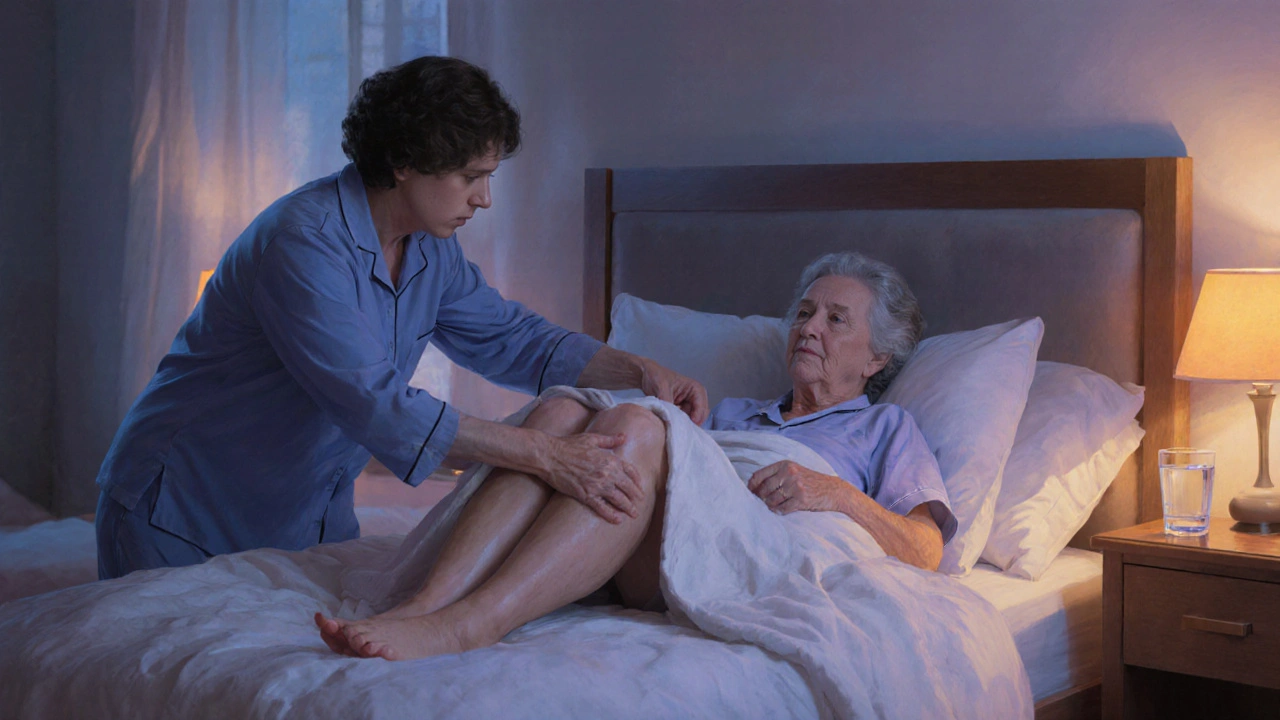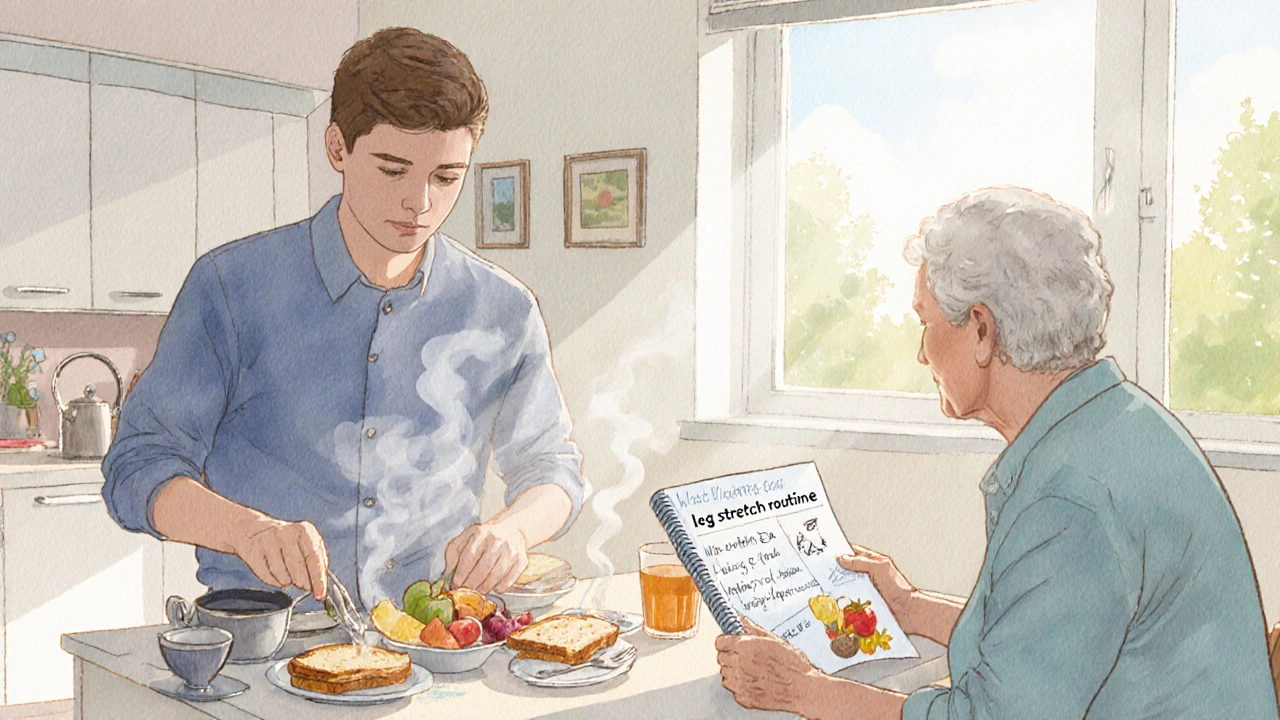
Imagine watching someone you love toss and turn each night, legs twitching like a metronome that never stops. That relentless urge to move can feel endless, and the frustration in their eyes is heartbreaking. You want to help, but you’re not sure where to start. This guide walks you through concrete ways to ease the nightly battle, from small daily habits to knowing when professional help is the right move.
Quick Takeaways
- Identify common RLS triggers such as caffeine, iron deficiency, and certain medications.
- Introduce gentle leg stretches and massage before bedtime.
- Make the bedroom a cool, calming space that supports good sleep hygiene.
- Encourage regular check‑ins with a qualified neurologista medical specialist who can diagnose and treat neurological disorders if symptoms persist.
- Consider supportive tools like compression stockings or a warm foot bath.
Understanding Restless Leg Syndrome
When we talk about Restless Leg Syndromea neurological condition that creates uncomfortable urges to move the legs, often worsening at night, the first thing to realize is that it’s not just “being fidgety.” The brain’s signaling pathways are out of sync, and the result is a compelling need to shift leg position to find relief.
Research shows that dopaminea neurotransmitter that regulates movement and mood plays a big role. Lower dopamine activity can make the sensations more intense, which is why many people with RLS find relief from medications that boost dopamine levels.
But medication isn’t the only solution, and for many families, lifestyle tweaks and emotional support make a huge difference.
Common Triggers to Keep an Eye On
Before you can offer effective help, you need to know what might be making the symptoms worse. Here are the usual suspects:
- Iron deficiency: Low iron stores are linked to poorer dopamine function. A simple blood test can reveal if iron supplementation is needed.
- Caffeinea stimulant found in coffee, tea, chocolate, and some sodas: Consuming it after mid‑afternoon can amplify leg sensations.
- Alcohol: While it may help you fall asleep, it often disrupts the sleep cycle and can intensify RLS later in the night.
- Certain medications: Antidepressants, antihistamines, and some blood pressure drugs have been reported to aggravate RLS.
- Prolonged inactivity: Sitting or standing still for hours can trigger the urge to move the legs.
Keeping a short symptom diary can help you and your loved one pinpoint patterns. Note the time of day, recent meals, caffeine intake, and any new meds.
How You Can Help on a Daily Basis
Support starts with simple, caring actions that reduce discomfort and promote relaxation.
- Gentle leg stretches: Encourage a few minutes of light stretching before bed. Moves like calf raises, ankle circles, or a seated hamstring stretch can calm the nerves.
- Foot massage: A warm hand‑off massage along the calves and feet can improve circulation and ease the urge to move.
- Warm‑cold therapy: Alternating a warm foot soak with a cool compress for a few minutes each can reset sensory signals.
- Hydration: Dehydration can worsen muscle cramps. Offer water throughout the day, but limit fluids right before bedtime to avoid nighttime bathroom trips.
- Encourage movement breaks: During long periods of sitting, suggest a quick walk or a set of leg lifts every hour.
These actions signal that you’re invested in their comfort without being overbearing.
Creating a Sleep‑Friendly Environment
Sleep hygiene is a cornerstone of RLS management. Small changes to the bedroom can make a big impact.
- Cool temperature: Aim for a room temperature between 60‑67°F (15‑19°C). Cool air helps reduce sensations in the legs.
- Dim lighting: Bright lights can suppress melatonin, the sleep hormone. Use soft lamps or blackout curtains.
- Comfortable bedding: Tight sheets can restrict leg movement. Choose breathable fabrics and ensure the mattress supports a neutral spine.
- White noise or soothing sounds: A steady background hum can mask the ticking of restless legs and promote deeper sleep.
When the space feels calm and inviting, the brain is more likely to enter restorative sleep stages, reducing the frequency of leg twitches.

Lifestyle Adjustments That Make a Difference
Some habits have a measurable effect on RLS severity. Here’s a quick comparison of non‑pharmacologic strategies versus medical interventions.
| Approach | Typical Onset of Relief | Effectiveness (average reports) | Side‑effects / Drawbacks |
|---|---|---|---|
| Leg stretches & massage | Immediately to 30 minutes | Moderate (40‑60% report improvement) | Requires daily commitment, minimal risk |
| Iron supplementation (if deficient) | 1‑2 weeks | High for iron‑deficient patients | GI upset, constipation |
| Compression stockings | Within minutes | Low‑to‑moderate (30‑50% notice less twitching) | May feel tight, must be properly sized |
| Dopamine agonist medication | Several days | High (70‑80% report significant relief) | Nausea, dizziness, potential for augmentation |
| Gabapentin or pregabalin | 1‑2 weeks | Moderate‑high | Weight gain, drowsiness |
Notice that many lifestyle tweaks work fast and have virtually no side‑effects. They’re worth trying before turning to prescription drugs, especially for mild‑to‑moderate cases.
When to Encourage Professional Care
If the symptoms disrupt daily life, cause chronic sleep loss, or don’t improve after a few weeks of home strategies, it’s time to involve a specialist. A board‑certified neurologista doctor trained to diagnose and treat disorders of the nervous system can run the necessary tests, such as blood work for iron levels, and discuss medication options.
Ask your loved one if they’re willing to schedule an appointment, and offer to accompany them for support. Being present during the visit can help them remember questions and feel less anxious.
Key red‑flags that merit immediate medical attention include:
- Sudden worsening of symptoms.
- Leg pain that feels like a cramp or throbbing.
- Signs of depression or anxiety related to chronic sleep loss.
- Any new medication that seems to trigger the episodes.
Tools and Products That Can Help
Some items are designed specifically for RLS relief. Below are a few that many caregivers find useful.
- Compression stockings: Look for graded compression (15‑20 mmHg) that fits snugly without cutting off circulation.
- Foam rollers or massage sticks: Simple devices for self‑massage that can be used before bed.
- Weighted blankets: The gentle pressure can calm the nervous system and improve overall sleep quality.
- Blue‑light blocking glasses: Wearing them an hour before sleep reduces melatonin suppression, supporting better rest.
Remember, these tools complement-not replace-healthy habits and, when necessary, medical treatment.
Checklist for Everyday Support
- Ask about caffeine or alcohol intake after 2p.m.
- Offer a short leg‑stretch routine before bedtime.
- Keep the bedroom cool, dark, and quiet.
- Check iron levels annually if RLS is chronic.
- Track symptom patterns in a simple journal.
- Schedule a follow‑up with a neurologist if sleep loss exceeds a few nights per week.
Having a clear, repeatable plan turns uncertainty into confidence-for both you and your loved one.
Frequently Asked Questions
What exactly triggers Restless Leg Syndrome at night?
Common triggers include low iron, caffeine, certain medications, and periods of prolonged inactivity. Even temperature changes can make the legs feel more restless.
Can lifestyle changes replace medication?
For many with mild‐to‑moderate symptoms, regular stretching, proper sleep hygiene, and iron supplementation (if needed) offer substantial relief. Severe cases often still benefit from medication, but lifestyle changes should be tried first.
How long does it take to see improvement after starting iron supplements?
Typically 1‑2 weeks, though full benefits may appear after a month of consistent dosing. Blood tests should be repeated to confirm iron levels normalise.
Are compression stockings safe for everyone?
They’re safe for most adults without severe peripheral vascular disease. Proper sizing is crucial-too tight can restrict blood flow.
What should I do if my loved one refuses medication?
Focus on non‑pharmacologic options first. Offer to join them in a nightly stretch routine, help adjust the bedroom environment, and gently discuss the benefits of a doctor’s opinion without pressure.
Supporting someone with Restless Leg Syndrome isn’t about a single magic cure-it’s a blend of empathy, practical habits, and knowing when to bring in professional care. By keeping an eye on triggers, encouraging gentle movement, and creating a calming sleep space, you can turn those restless nights into more peaceful ones.
Restless Leg Syndrome support starts with small, consistent actions. Stay patient, stay informed, and remember that every step forward, however tiny, brings both of you closer to restful sleep.
nathaniel stewart
September 28, 2025 AT 13:55Dear friends, I commend your dedication to supporting a loved one with Restless Leg Syndrome; your compassion is truly admirable. By diligently monitoring caffeine intake and ensuring adequate iron levels, you can significantly alleviate symptoms. Moreover, establishing a consistent bedtime routine fosters a tranquil environment conducive to restful sleep. Please consider encouraging gentle stretching exercises prior to bed, as they have been shown to provide immediate relief. Remember, your consistent presence offers immeasurble emotional support, which is as vital as any physical intervention. Together, we can transform restless nights into peaceful slumber.
Pathan Jahidkhan
October 8, 2025 AT 01:55Life is a restless tide and the legs are its relentless drums yet we dance on
ADETUNJI ADEPOJU
October 17, 2025 AT 13:55Indeed, the pathophysiology elucidates dopaminergic dysregulation yet the layperson’s reservoir of compliance remains critically suboptimal. One might postulate that the etiological matrix is merely an opportunistic vector for non‑adherence, a truly fascinating conundrum. It is almost as if we expect miracles without acknowledging the neurochemical underpinnings. Such optimism is, of course, delightfully naive.
Jessica Romero
October 27, 2025 AT 01:55I must say, the depth of research presented here is commendable, and it provides a robust scaffold for caregivers seeking actionable strategies. The emphasis on iron supplementation aligns perfectly with the established literature indicating that iron deficiency can exacerbate dopaminergic deficits. Furthermore, the suggestion to limit caffeine after mid‑afternoon is both pragmatic and evidence‑based, given caffeine’s role as an adenosine antagonist that can heighten neuronal excitability. The inclusion of warm‑cold therapy is particularly inventive, offering a bidirectional modulation of peripheral sensory receptors. In addition, the recommendation to maintain a bedroom temperature between 60 and 67 degrees Fahrenheit is grounded in thermoregulatory science, which suggests cooler environments can reduce peripheral nerve firing rates. The advice to employ white noise as a masking agent is also supported by studies showing improved sleep continuity in noisy settings. Moreover, the comprehensive checklist serves as an excellent daily reminder, ensuring that caregivers do not overlook critical variables such as hydration and movement breaks. I also appreciate the nuanced discussion regarding when to seek professional medical care, which balances self‑efficacy with prudent medical oversight. The table contrasting lifestyle strategies with pharmacologic interventions offers a clear visual hierarchy of expected onset of relief and side‑effect profiles. It is worth noting that compression stockings, while low‑risk, require proper sizing to avoid iatrogenic vascular compromise. The discourse on weighted blankets adds an additional layer of sensory integration therapy, which is increasingly recognized in sleep medicine. The suggestion to use blue‑light blocking glasses before bedtime is a subtle yet powerful tool to preserve endogenous melatonin secretion. Additionally, the emphasis on emotional support underscores the biopsychosocial model of chronic disease management. From a caregiver’s perspective, the article’s tone is both empathetic and empowering, fostering a sense of agency. Finally, the balanced integration of non‑pharmacologic and pharmacologic options reflects a patient‑centered approach that honors individual preferences and clinical realities. In sum, this guide stands as a valuable resource that can translate complex neurophysiological concepts into tangible bedside practices.
Michele Radford
November 5, 2025 AT 13:55The article, while thorough, neglects to address the socioeconomic barriers that prevent many patients from accessing compression stockings or weighted blankets. It also overlooks the fact that iron supplementation is not universally effective without thorough hematologic evaluation. Such omissions diminish the overall applicability of the recommendations.